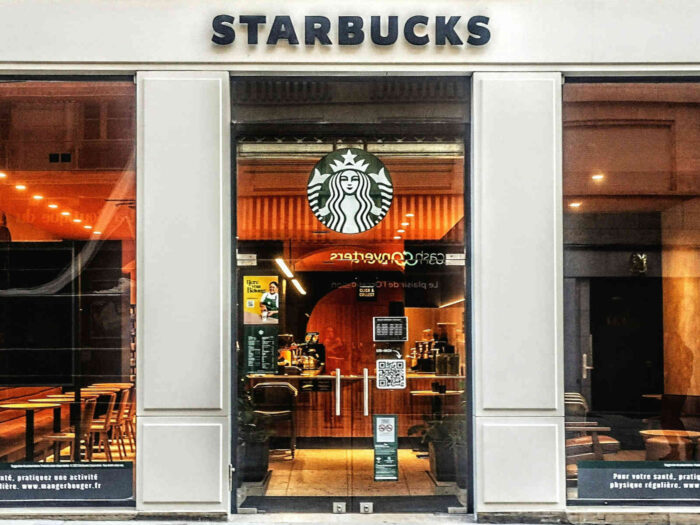
Starbucks Corporation is an industry leader with one of the strongest international brands and with strategies effectively aligned with the external trends identified in this PESTEL analysis (PESTLE analysis).
Business success as the world’s biggest coffeehouse chain is attributed to the company’s ability to address external factors. This PESTEL analysis (or PESTLE analysis) indicates external influences in the remote or macro-environment affecting Starbucks’ success.
To maintain its industry position, Starbucks adapts to the external environment characterized in this PESTEL analysis. Addressing the external factors identified in this PESTEL analysis of Starbucks furthers long-term coffeehouse business goals.
This PESTLE analysis presents business issues that Starbucks must account for in its competitive strategies against coffee and foodservice firms, like Dunkin’, Tim Hortons, McDonald’s, Subway, Wendy’s, and Burger King.
The Five Forces analysis of Starbucks demonstrates strong external pressure from these competitors shaping the industry environment examined in this PESTEL analysis. Such competitive pressure influences strategies for the coffeehouse chain.
Political Factors Affecting Starbucks
This part of the PESTEL analysis framework identifies the impact of governments and related policies on the coffeehouse business. Starbucks experiences the following political factors in its macro-environment:
- Integration and disintegration of markets (opportunity and threat)
- Improving governmental support for infrastructure (opportunity)
- Bureaucratic red tape in developing countries (threat)
Political integration and disintegration of regional markets (e.g., single-market and free-trade policies) are an external factor that presents opportunities and threats to Starbucks and its global growth.
In this PESTLE analysis case, integration facilitates regional market penetration, which is an opportunity for Starbucks. In contrast, disintegration creates barriers (threat) to the coffeehouse company’s business growth and expansion.
Also, governmental policies for improving infrastructure create opportunities for Starbucks to access more customers and suppliers. However, bureaucratic red tape persists in many countries. This political factor is a threat because it impedes the coffee company’s business expansion, while possibly favoring local competitors that have extensive political connections.
Thus, this PESTLE analysis of Starbucks presents opportunities but also points out political obstacles in growing the business. Despite these political factors, opportunities involving agreements or deals with governments could emerge and favor Starbucks’ business growth.

Economic Factors influencing the Coffeehouse Chain
This component of the PESTLE analysis refers to the economic conditions and trends that affect the coffee and foodservice business. Starbucks faces the following economic factors in the remote environment:
- Growth of developing countries (opportunity)
- Declining unemployment rates in the long term (opportunity)
- Rising labor cost in coffee suppliers’ countries (threat)
The growth of developing countries and the declining unemployment rates are economic trends that create opportunities for Starbucks to increase its sales revenues from various markets around the world.
However, the rising labor cost in developing countries is an external factor that threatens Starbucks because it increases the company’s spending on ingredients. The firm sources much of its coffee beans from developing countries.
Thus, this part of the PESTEL analysis of Starbucks presents mostly opportunities, although the rising labor costs in coffee suppliers’ countries is an issue that could lead to higher business costs and higher prices at the company’s coffeehouses.
Social Factors in Starbucks’ External Environment
This aspect of the PESTEL analysis shows the social conditions and trends influencing consumers and the coffeehouse business. Starbucks must address the following social/sociocultural factors in its macro-environment:
- Growing coffee culture (opportunity)
- Growing middle class (opportunity)
- Increasing health consciousness (opportunity)
- Independent coffeehouse movements (threat)
Starbucks has opportunities to increase its revenues based on increasing demand for specialty coffee, which is due to a growing coffee culture and growing middle class populations around the world.
Also, in this PESTLE analysis case, Starbucks can widen its array of more healthful products to attract health-conscious consumers to its coffeehouses and merchandise. This social factor influences consumer preferences and demand for specific food and beverage characteristics.
Despite these opportunities, Starbucks faces threats linked to independent coffeehouse movements, which are sociocultural movements that favor small independent coffeehouses instead of large multinational chains. This threat is also identified in the SWOT analysis of Starbucks Corporation.
Thus, the external factors in the social aspect of this PESTLE analysis present business growth opportunities, but also a considerable social threat that can limit the coffeehouse chain’s market penetration.

Technological Factors in the Coffeehouse Business
In this part of the PESTLE analysis, technologies and related trends are identified, pertaining to their effects on the coffeehouse chain. Starbucks experiences the following technological factors in its remote environment:
- Increasing adoption of mobile technology for online purchases (opportunity)
- Technology transfers to coffee farmers (opportunity)
- Rising availability of specialty coffee machines for home use (threat)
Starbucks has opportunities to improve its mobile apps and linked services to grow its revenues through mobile ordering. In this PESTEL analysis case, such a technological factor creates opportunities to strengthen the company’s online presence and marketing.
Starbucks can also improve its supply chain efficiency based on recent technologies that coffee farmers use. The company can initiate technology development and transfers that benefit coffee farmers and, consequently, the coffeehouse chain.
However, the rising availability of home-use specialty coffee machines threatens Starbucks by competing with the company’s At-Home coffee products and coffee machines, and by increasing the probability of substitution for the company’s in-store beverages. In this PESTLE analysis case, such an external factor involves consumers who prefer convenient at-home coffee.
Thus, the technological factors in this PESTEL analysis of Starbucks show the importance of products that effectively compete while addressing new and emerging technologies affecting the industry.
Ecological Factors affecting Starbucks
This component of the PESTEL analysis identifies the effects of ecological or environmental conditions and trends on the coffeehouse business. Starbucks faces the following ecological/environmental factors in its macro-environment:
- Increasing availability and adoption of sustainable processes in businesses (opportunity)
- Growing access to responsibly sourced materials or ingredients (opportunity)
- Rising support for environmentally friendly products (opportunity)
The increasing availability of sustainable business processes is a trend that gives Starbucks opportunities to enhance its sustainability standards and implementations. In this PESTLE analysis case, such enhancement can strengthen the company’s brand image and attract more customers to its foods and beverages.
Responsible sourcing emphasizes Starbucks’ corporate social responsibility, ESG, and stakeholder management, especially in the supply chain. In this PESTEL analysis case, the coffee company has opportunities to enhance its performance in these business areas. The corporation can continue to improve its existing responsible sourcing policies, such as for its coffee supply and procurement.
Moreover, Starbucks can innovate to make its products more environmentally friendly. For example, the company can increase the use of recyclable materials for packaging food products and other merchandise.
Thus, the ecological factors in this PESTLE analysis of Starbucks show opportunities for strengthening the corporate image based on the ecological impact of the business. Corresponding strategies can also lead to improved coffeehouse business competitiveness in the long term.

Legal Factors
The legal factors in this PESTEL analysis case are laws, regulations, and related trends that impose requirements on the coffee business. Starbucks must address the following legal factors in its remote environment:
- Product safety regulations (opportunity)
- Developing GMO regulations (opportunity and threat)
- Increasing employment regulations (opportunity and threat)
Starbucks has opportunities to improve its performance by satisfying product safety regulations. Similarly, the company can enhance its supply chain to address regulations on ingredients from genetically modified organisms (GMOs). Starbucks is already performing well in these aspects, but further improvements can boost business performance.
Also, employment regulations, especially in developing countries, threaten Starbucks’ access to the labor market and competitively priced coffee beans. In this PESTLE analysis case, such an external factor impacts the coffee business through increased spending for human resources and for coffee beans and other materials. Nonetheless, Starbucks can implement new strategies to improve human resource management and supply chain management.
Thus, in this aspect of the PESTEL analysis of Starbucks, the identified legal factors present opportunities as well as threats that influence the business as it continues its multinational growth.
Recommendations based on this PESTLE/PESTEL Analysis of Starbucks
This PESTLE analysis of Starbucks shows that most of the external factors in the remote or macro-environment present opportunities. However, the company must work on innovation and marketing to address the identified threats, such as the threat of substitution linked to the increased availability of home-use specialty coffee machines.
Also, this PESTEL analysis shows that improving operations and business processes to build on the identified opportunities can contribute to the fulfillment of Starbucks’ mission statement and vision statement.
A holistic strategic approach based on these opportunities and threats can ensure the company’s long-term leadership in the coffeehouse industry. Overall, this PESTEL/PESTLE analysis supports the following recommendations for Starbucks:
Recommendation 1. Develop Starbucks products (existing or new) to further address health-conscious consumers’ preferences, which is an opportunity in this PESTEL analysis case. This opportunity represents long-term conditions that shape the coffee market.
Recommendation 2. Improve the product development and distribution of Starbucks coffee machines for home use. This recommended action aims to mitigate the effects of the rising availability of specialty coffee machines for home use, which is a threat in this PESTLE analysis case.
Recommendation 3. Enhance the development of Starbucks Coffee At-Home products and improve the distribution of such merchandise. This recommendation also targets the threat of the rising availability of specialty coffee machines for home use.
References
- About Starbucks Coffee Company.
- Kekes, T., Koskinakis, S. E., Boukouvalas, C., & Krokida, M. (2025). Enhancing environmental sustainability in the coffee processing industry via energy recovery and optimization: A life cycle assessment case study. Sustainability, 17(3), 1334.
- Rodrigues, C., Trindade, C., Geraldo, S., Assude, P., Nunes, J., Beato, J. C., … & Nabeiro, R. M. (2025). Threats, challenges, and solutions to the coffee crop under a climate change scenario – An industry perspective. Advances in Botanical Research, 114, 589-617.
- Starbucks Corporation Business Ethics and Compliance.
- Starbucks Corporation Form 10-K.
- U.S. Department of Agriculture – Economic Research Service – Food Service Industry Market Segments.
- Zhang, B., & Ip, W. S. C. (2025). Starbucks’ critical success factors based on customer perception. Highlights in Business, Economics and Management, 49, 104-119.